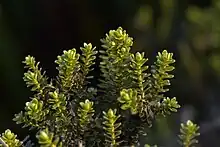| Stigmella cassiniae | |
|---|---|
 | |
| Male holotype | |
| Scientific classification | |
| Domain: | Eukaryota |
| Kingdom: | Animalia |
| Phylum: | Arthropoda |
| Class: | Insecta |
| Order: | Lepidoptera |
| Family: | Nepticulidae |
| Genus: | Stigmella |
| Species: | S. cassiniae |
| Binomial name | |
| Stigmella cassiniae Donner & Wilkinson, 1989 | |
Stigmella cassiniae is a moth of the family Nepticulidae.[1] This species is endemic to New Zealand and has been observed in the North and South Islands. The larvae are leaf miners of leaves and stems of Ozothamnus leptophyllus. When mature the larvae pupate amongst leaf litter on the ground. Adult moths have been recorded on the wing in January, February, April and October. It has been hypothesised that there are likely two generations in a year.
Taxonomy
This species was first described in 1989 by Hans Donner and Christopher Wilkinson from specimens collected in the Gisborne, Hawkes Bay, Taranaki and Southland regions. The male holotype specimen, collected at Cheviot Face in the Takitimu Range on 30 January 1976 on Cassinia vauvilliersii (now known as Ozothamnus leptophyllus) by J. S. Dugdale, is held in the New Zealand Arthropod Collection.[2]
Description
Larvae are 2–3 mm long and orange-brown. Adult moths have forewings with a length of between 2–3 mm. Donner and Wilkinson described the adult male of this species as follows:
Head. Frontal tuft buff; scape and collar pale grey to whitish; antenna brown, lustrous, reflecting gold, comprising 29 segments. Thorax grey. Forewing 2–3 mm long, golden brown, iridescent, reflecting gold and silver; fringe concolorous. Hindwing silvery grey, lustrous, reflecting silver; fringe silvery white. Abdomen concolorous.[2]
Donner and Wilkinson went on to described the adult female as follows:
As for male, but antenna comprising 22 segments.[2]
This species is easily identified by its small size and its forewing colouration of golden brown.[2]
Distribution
This species is endemic to New Zealand and has been observed in the North and South Islands.[3][4] The species has been observed at Mt. Benger at an altitude of 1,100 metres (3,600 ft).[5]
Behaviour
Larva have been recorded in May, July, August and October. They mine the leaves of their host plant. The mine is circular in the early stage, later occupying entire the leaflet. The larvae then mine through the stem to another nearby leaflet. Up to five leaflets may be consumed before the larva matures.[2] The cocoon is spun amongst debris on the ground. Reared moths emerged August, September and November. Adults have been recorded on the wing in January, February, April and October. There are probably two generations per year.[2]
Host

The larvae feed on Ozothamnus leptophyllus.[6]
References
- ↑ Erik J van Nieukerken; Camiel Doorenweerd; Robert J B Hoare; Donald R Davis (31 October 2016). "Revised classification and catalogue of global Nepticulidae and Opostegidae (Lepidoptera, Nepticuloidea)". ZooKeys. 628 (628): 65–246. doi:10.3897/ZOOKEYS.628.9799. ISSN 1313-2989. PMC 5126388. PMID 27917038. Wikidata Q28109648.
- 1 2 3 4 5 6 Hans Donner; Christopher Wilkinson (28 April 1989). "Nepticulidae (Insecta: Lepidoptera)" (PDF). Fauna of New Zealand. Department of Scientific and Industrial Research. 16: 18–19. doi:10.7931/J2/FNZ.16. ISSN 0111-5383. OCLC 924829916. Wikidata Q45079930. Archived from the original (PDF) on 26 July 2021.
- ↑ Gordon, Dennis P., ed. (2010). New Zealand inventory of biodiversity: Kingdom animalia : chaetognatha, ecdysozoa, ichnofossils. Vol. 2. p. 461. ISBN 978-1-877257-93-3. OCLC 973607714. OL 25288394M. Wikidata Q45922947.
- ↑ "Stigmella cassiniae Donner & Wilkinson, 1989". www.nzor.org.nz. Landcare Research New Zealand Ltd. Retrieved 8 July 2018.
- ↑ K. J. M. Dickinson; A. F. Mark; B. I. P. Barratt; B. H. Patrick (March 1998). "Rapid ecological survey, inventory and implementation: a case study from Waikaia Ecological Region, New Zealand". Journal of the Royal Society of New Zealand. 28 (1): 83–156. doi:10.1080/03014223.1998.9517556. ISSN 0303-6758. Wikidata Q54578259.
- ↑ "Stigmella cassiniae Donner & Wilkinson, 1989". plant-synz.landcareresearch.co.nz. 2011. Retrieved 4 October 2023.